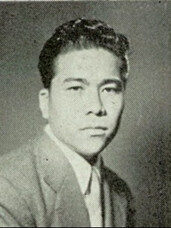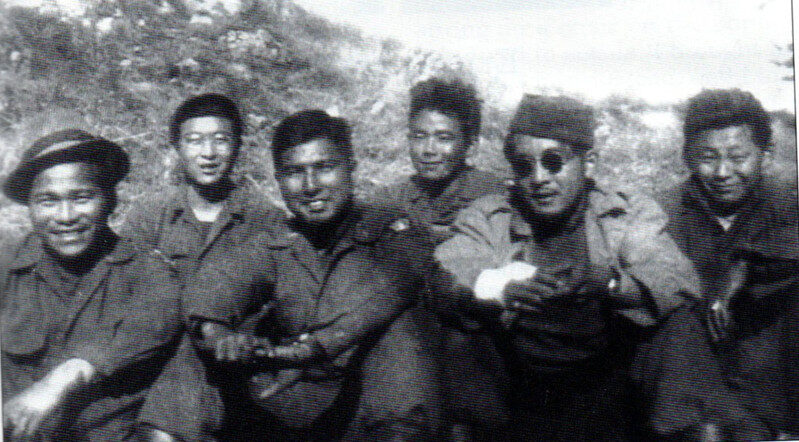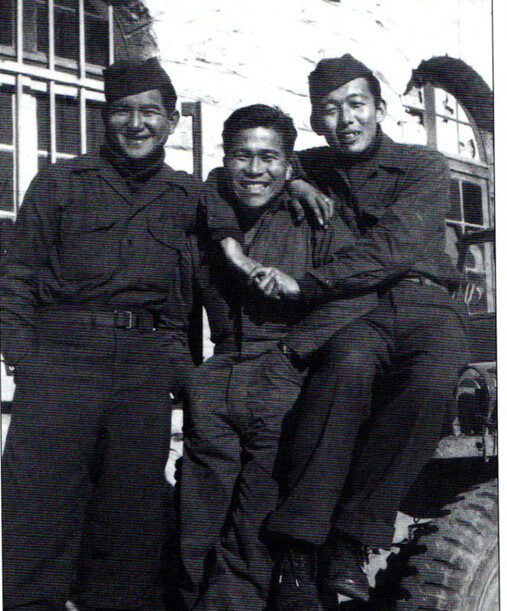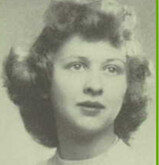Soldier Story: Sugure Roy Kanno
Soldier Story

Sugure Roy Kanno
Staff Sergeant
442nd Regimental Combat Team
3rd Battalion, I Company
Sugure Roy Kanno was born on October 24, 1924, in Papaikou, Hawaii island, Territory of Hawaii, to Mikichi and Katsuyo (Watanabe) Kanno. His siblings were brothers Raymond Mareshi, Masuke, Richard Mareo, and Eddie Mutsumu, and sisters Marimi, Marii, and Reiko.
Mikichi Kanno arrived in Hawaii at the age of 21 on April 30, 1903, on the Nippon Maru from Fukushima Prefecture, Japan. Katsuyo arrived at the age of 16 on the Tenyo Maru from the village of Monden, Fukushima Prefecture, on September 23, 1913. She was meeting her father, Gensaburo Watanabe, in Hilo. By 1915, she had married Mikichi. In 1920, they lived in Papaikou where Mikichi worked for the Onomea Sugar Company.
In 1930, the family lived on Punawai Street and father Masuo (so listed in the Federal Census) owned his own truck and did general hauling. By 1940, mother Katsuyo had died and Mikichi and his children Sugure, Reiko, and Mutsumu lived at 736 Punawai Street. The Genichi Maruhashi family lived with them. Mikichi was 60 years old and a helper on a farm. This year, Sugure was in the 9th grade at Hilo Intermediate School where he was on the Honor Roll.
Kanno signed his draft registration card on December 19, 1942, Local Board No. 2, in Room 7 of Hilo’s Professional Building. His father was his point of contact, they lived at the 736 Punawai Street home, and he was a student at Hilo High School. He was 5’4” tall and weighed 140 pounds. On December 30, 1942, just 18 years old, Sugure became a donor along with other high school students at Hilo Memorial Hospital’s blood drive.
He enlisted on March 27, 1943, in Hilo, in the second group of Hilo men. At the time, he was a senior at Hilo High School (photo above). Inductions were held at the Hilo Armory and the men were instructed to arrive without baggage and just a few toiletries, as their civilian clothes would be returned to their home address after uniforms and equipment were issued.
Roy, as he was known, immediately was sent to Honolulu with the other men who were inducted that day. They arrived at Iolani Palace just in time for the community’s farewell ceremony to the new soldiers of the 442nd. Afterwards, he and the other new men went with the larger group to their “tent city” known as Boom Town at Schofield Barracks. On March 30, a notice was printed in the Hilo Tribune-Herald:
In Appreciation – My father Mikichi Kanno joins me in extending sincere thanks and appreciation to our many friends for the gifts and kindnesses bestowed upon me at the time of my induction into the U.S. Army. I especially wish to thank the members of the Hi-Y Club and the student body of Hilo High School. I shall try to do my part in serving our country with honor until victory will be ours. ~~Punawai Street~~
They sailed for California on the S.S. Lurline on April 4. After arriving in Oakland, the new men of the 442nd were transported by train to Camp Shelby, Mississippi, arriving on April 18. Roy was assigned to the 3rd Battalion, I Company, 2nd Platoon. That fall, while at Camp Shelby, Pfc. Kanno was promoted to the rank of Corporal.
After a year of basic, unit, and combat training and field maneuvers, the 442nd left Camp Shelby for Camp Patrick Henry, Virginia, on April 22, 1944. They shipped out to the Mediterranean Theater of Operations in a large convoy of troop ships on May 2, and arrived at Naples, Italy, on May 28 to fight in the Rome-Arno Campaign.
After a week at a bivouac in nearby Bagnoli, the RCT moved by LSTs to the Anzio beachhead. From there, they were trucked around the recently liberated city of Rome to a large bivouac near Civitavecchia, about 50 miles north. Here, they made final preparations to move to the front. The 442nd entered combat on June 26 near Suvereto.
The push of the 442nd up the west side of the Italian peninsula was relentless. They saw heavy combat at Hill 140, and continued to move the enemy north. Finally, they were pulled from the lines north of the Arno River and sent to Naples for shipment to France, where they joined in the Rhineland-Vosges Campaign. They arrived at Marseilles on September 29 after a 2-day voyage, and bivouacked at nearby Septèmes prior to traveling over 500 miles north by truck or rail boxcars to the Vosges Mountains.
S/Sgt. Kanno was in combat for the next month during the bitter fighting to liberate the important road and rail junction of Bruyères, neighboring Biffontaine and Belmont, and the “Rescue of the Lost Battalion” – the 1st Battalion, 141st (Texas) Infantry that had advanced beyond the lines and was surrounded on three sides by the enemy.
The weather was cold, wet, snowy, and miserable, as the men fought in the heavily wooded forests still in their summer uniforms. They were subjected to living in wet foxholes, and incoming artillery raining down on them in “tree bursts.”
The initial objective of the Texas “lost” battalion had been to clear the Germans from the entire long, densely forested ridge where it had become surrounded – until their rescue by the 442nd. This rescue was the most intense combat the men had seen yet. Kanno’s I Company was in one of two leading battalions and suffered very high casualties. After the rescue, the 3rd Battalion was ordered to push on down to the end of this ridge. On November 5, the higher command decided that the town of St.-Dié, in the valley, needed to be taken. The 3rd Battalion met stiff resistance from the Germans, and ended the day withdrawing to their original positions.
At some point during the Vosges fighting, Kanno was wounded, sent to an aid station and then to the field hospital. The nature of his wound was not discovered in our research.
The fighting would go on until November 9. The German line was completely shattered, but 442nd losses were so great that the Combat Team was temporarily ineffective as a fighting force.
As a result, it was sent to the south of France to participate in the Rhineland-Maritime Alps Campaign. This was mostly a defensive position guarding the French-Italian border from enemy incursion. The men were stationed in the mountains and often given day passes to enjoy the towns of Nice and Menton. For this reason, this time was nicknamed the “Champagne Campaign.” The men were there from November 23, 1944. At the end of December, it was reported in the Honolulu Star-Advertiser that Staff Sergeant Sugure Roy Kanno had recuperated from his wound and returned from the hospital to his unit.
Below: Group of 2nd Platoon men, likely late 1944/early 1945, Maritime Alps, left to right – Roy Kanno, Roy Gikiu, Sadaichi Kubota, Danny Kuniyoshi, Mike Takemoto, Hideo Takahashi

Below: Kanno (center) with buddies Kiichi Kato and Shigenori Matsumoto, possibly late 1944/early 1945 in Nice

On March 15, 1945, the 442nd was relieved from duty in the Maritime Alps and moved to a new staging area at Marseilles. On March 20-22, the Combat Team (without its 522nd Field Artillery Battalion who were sent to Germany) left France to fight in the Po Valley Campaign for the final push to defeat the Nazis in Italy.
They arrived at the Peninsular Base Section in Pisa on March 25 and were assigned to Fifth Army. It was intended that the presence of the 442nd back in Italy would be a total surprise to the enemy. For this reason, all movements were done in the utmost secrecy. The objective of the 442nd in the Po Valley Campaign was to launch a diversionary attack on the western anchor of the German Gothic Line in Italy.
The center of this elaborate system of fortifications had been pierced in the fall of 1944, but no one had yet been able to pry the Germans loose from the western end. The Gothic Line in this area was hewn out of solid rock, reinforced with concrete, and constructed as to give all-around protection and observation. They were dug into mountain peaks rising almost sheer from the coastal plain, bare of vegetation save for scanty scrub growth.
The Combat Team left their staging area and moved to a bivouac at San Martino, near the walled city of Lucca. Starting at 10:00 p.m. on April 4, Companies I and L set off from the hilltop town of Azzano to descend to the valley floor, and then began a long climb, in the dark of night, up to the saddle between Mount Folgorito and Mount Carchio. The men, in full battle gear, crawled for the most part on their hands and knees or pulled themselves up the shale-covered slope by a low-hanging shrub or the rifle butt of the man above him. After an 8-hour climb, they reached the top and began their attack at 6:00 a.m. The enemy was totally surprised and the ridge was secure by 7:30 a.m.
After this success, the 442nd pushed the Germans north from Mount Folgorito, and on to Montignoso, Massa, across the Frigido River, Carrara, and Mount Pizzacuto. They took the key rail center of Aulla on April 25. On April 28, they were in the town of Genoa, which had surrendered the day before.
What began as a diversionary attack was relentlessly pursued by the Combat Team, resulting in a complete breakthrough of the Gothic Line in the west. By the end of April, Germans were surrendering by companies, battalions, and regiments.. Despite orders from Hitler to fight on, the German forces in Italy surrendered on May 2, a week before the rest of the German forces in Europe surrendered on May 9, 1945.
On that day, May 9, it was reported in the Honolulu Star-Advertiser that S/Sgt. Sugure Roy Kanno and 15 other Big Island soldiers had been wounded in the European Theater. The nature of his wound was not reported.
Following the surrender, the 442nd moved to bivouac at Novi Ligure. On May 16 the 442nd was moved to Ghedi Airfield near Brescia, where they guarded and processed German prisoners of war. They moved a month later, on June 14, to Lecco, and, finally, on July 24 to the Livorno/Pisa/Florence area.
Staff Sergeant Kanno was with his company for the occupation before leaving Italy in the fall of 1945. He arrived back in Hawaii on the troop ship USAT Evangeline on December 19 at Pier 24 in Honolulu Harbor, one of 850 returning veterans. The dock was crowded with well-wishers who were allowed an hour to greet the men before they were trucked to the Army Separation Center at Fort Kamehameha for processing. He was discharged on January 2, 1946, in Honolulu.
For his World War II service, Staff Sergeant Sugure Roy Kanno earned the: Bronze Star Medal, Purple Heart Medal with one oak leaf cluster, Good Conduct Medal, European-African-Middle Eastern Campaign Medal with four bronze star devices (for four campaigns), World War II Victory Medal, Army of Occupation Medal, Distinguished Unit Badge with one oak leaf cluster, and Combat Infantryman Badge. He was posthumously awarded the Congressional Gold Medal on October 5, 2010, along with the other veterans of the 100th/442nd Regimental Combat Team. Conferred by the U.S. Congress, the award states: “The United States remains forever indebted to the bravery, valor, and dedication to country these men faced while fighting a 2-fronted battle of discrimination at home and fascism abroad. Their commitment and sacrifice demonstrates a highly uncommon and commendable sense of patriotism and honor.ˮ
On September 12, 1947, Roy flew from Honolulu on United Airlines enroute to Wisconsin. According to the newspaper, he was among five local men who enrolled at the Milwaukee School of Engineering in a Practical Electronics course. In March 1949, the newspaper reported that Kanno was a candidate for an Electronics Technician Certificate and he planned to continue his studies in the new term.
Below: Estelle’s senior class photo, 1947

While in Milwaukee, Roy met Estelle Dorothy Andrzejewski. She was born on July 17, 1929, to Mr. and Mrs. Stanislaw Andrzejewski. Her father was an immigrant from Poland. They married on September 3, 1949. The following year, they were living in an attic apartment at 2545 Clarke Street. Roy was employed by a car buffer business and Estelle worked in the telephone company office. By 1955, they were living at 3440-A North 11th Street and Roy was working as a die caster for Louis Allis. They settled in Brown Deer, a suburb on the north side of Milwaukee, and over the years raised a family of one son and two daughters.
In 1957, Roy’s father Mikichi Kanno died in Hilo. He was survived by sons Raymond M., Richard M., and Eddie M. of Honolulu and Roy S. of Milwaukee; and daughters Maremi Kanno of Hilo, Mrs. Marie Komoda of Honolulu, and Mrs. Reiko Hamasaki of Kapulena, Hawaii island.
After retirement, Roy and Estelle moved to Peoria, a suburb on the northwest side of Phoenix, Arizona, after retirement. They divorced sometime in the early 1970s.
Roy Sugure Kanno died on August 19, 2000, in Peoria. His survivors included one son, one daughter, and nine grandchildren. His daughter Mrs. Gaye Elizabeth Kanno Carson predeceased him in 1996. His memorial service was held at St. Charles Borromeo Catholic Church on August 25. Roy Kanno was buried at the Wisconsin Memorial Park in Brookfield, Wisconsin.
Researched and written by the Sons & Daughters of the 442nd RCT in 2025 at the request of his daughter.